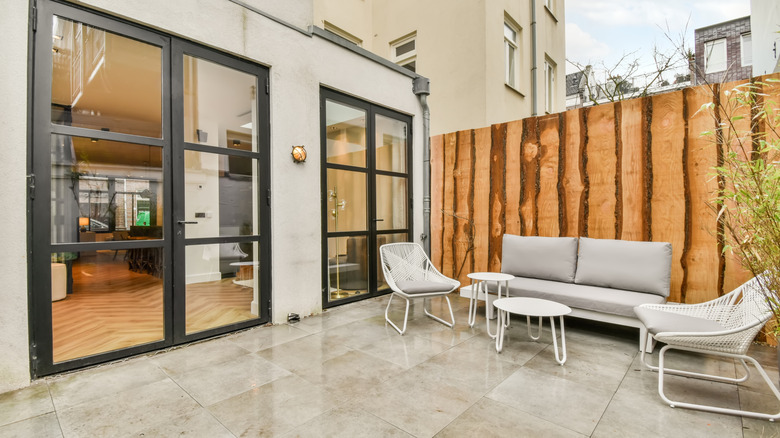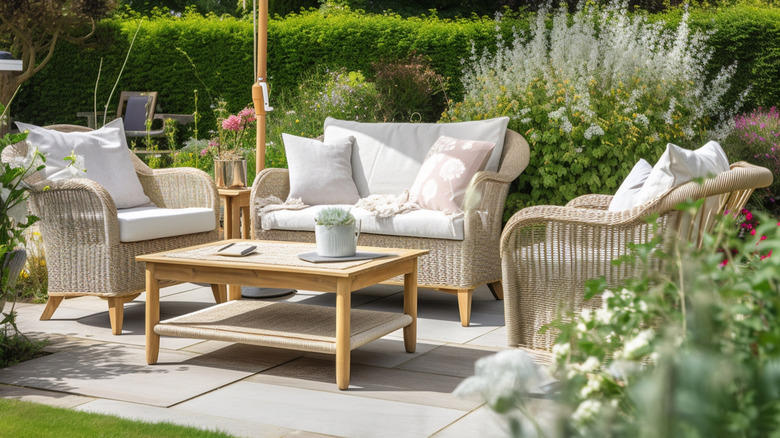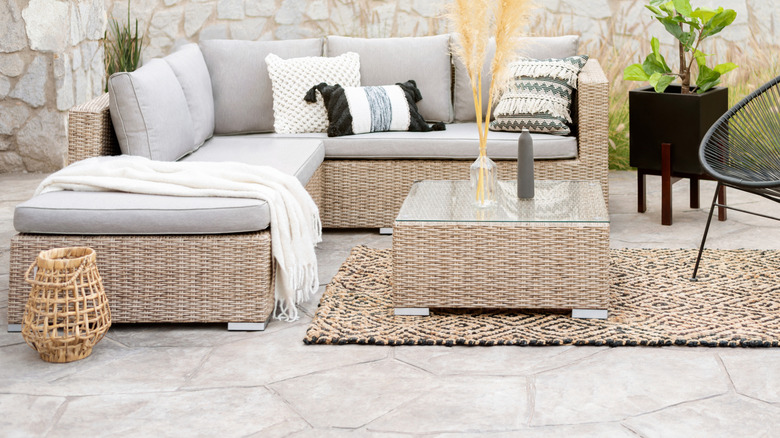The Small Patio Design Trick That Will Make Your Space Feel Bigger
There is hardly anything better than sitting outside on a stylish, welcoming patio, enjoying a beautiful evening with loved ones. The best part is that you do not need a massive space to create an outdoor patio oasis in your own backyard. In fact, when treated correctly, small spaces actually foster more coziness, intimacy, and connection than their sprawling counterparts.
Still, while you want your patio to have that close hygge feeling, complete with thoughtful furniture arrangements and atmospheric lighting, you also don't want it to look like it's the size of a postage stamp. So how exactly do you help make a small patio space appear larger when you don't actually have a lot of square footage to work with?
Tricking the eye into reading a small outdoor area as larger all starts with the material you use to create it. By choosing a larger format tile, paver, or stone for the flooring, you reduce the visual distraction and create a streamlined foundation that appears more expansive than if you used a smaller material option. Let us guide you on turning your small patio into a dream space, despite its tiny little footprint.
Tricking the eye with large format tiles or pavers
Similar to the popular trend of using supersized tiles to maximize a small bathroom, the same logic applies to the optics of outdoor patio spaces. Smaller tiles, pavers, or bricks with a lot of grout, mortar, or separation cause the eye to stop moving at each break and register each tile. This makes the space appear busy and small, as well as almost claustrophobic with the overwhelming amount of visual clutter. In addition, dirt tends to gather in the divots of grout or mortar, making patios with a lot of it harder to clean.
Conversely, large format floor tiles or pavers create a more seamless patio design with less visual noise to cause distraction. Since the eye is not being forced to stop as often, it allows the flooring to read more as one large unit rather than a mishmash of small individual parts. This creates an airier, more streamlined look that makes the space feel more expansive and open. In addition, choosing materials in light to mid-tone earthy hues and neutrals will also help it feel larger and more connected to its surroundings.
Large format patio material and design options
Large format tile doesn't necessarily mean you are stuck with basic rows of contemporary rectangular or square pavers if that is not your aesthetic. If you like the simplicity but want something warmer, try spacing out your large patio pavers a few inches and adding sod in-between to blur the lines between the patio area and the outdoors. This also softens the aesthetic, creating a sophisticated, streamlined, and yet natural quality to the space.
Alternatively, rather than a straightforward geometric format, opt for an over-sized limestone, bluestone, or flagstone patio to bring in the beauty of imperfect, organic shapes. You will see more filler between these stones due to their unique shapes, which should be selected to match and blend with the stones as much as possible instead of a contrast filler. Between a tone-on-tone filler, supersized scale, and the ability to tailor the freeform shape to maximize every inch of the available landscape, these organic natural stone patios are a stunning choice for making a small patio upscale, connected to nature, and feeling bigger than it is. No matter the material that best suits your personal aesthetic, opt for a large scale format in a soft earth tone to give your tiny patio the open, airy, and expansive vibes you've been dreaming of.


